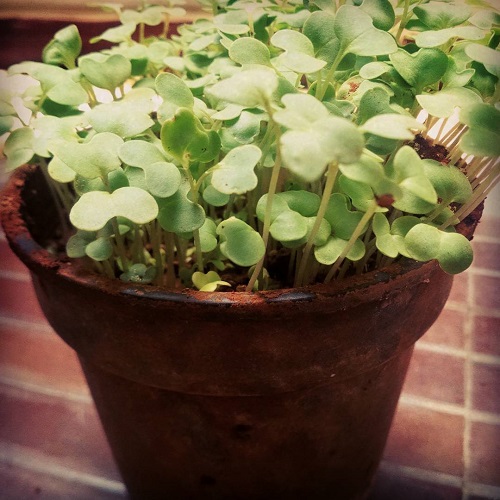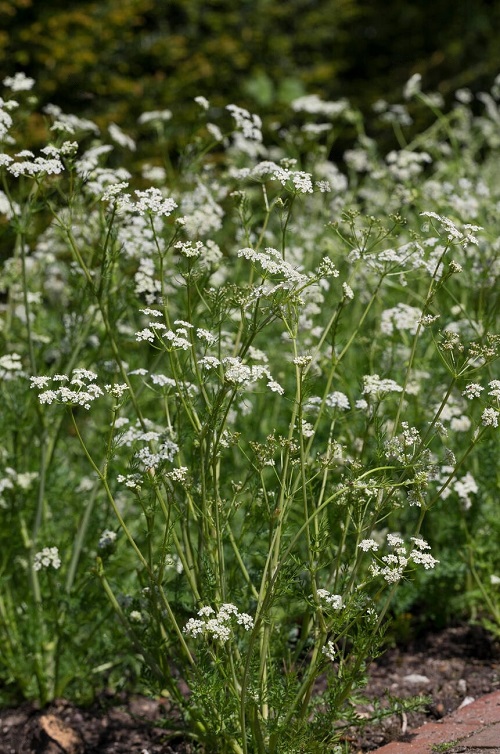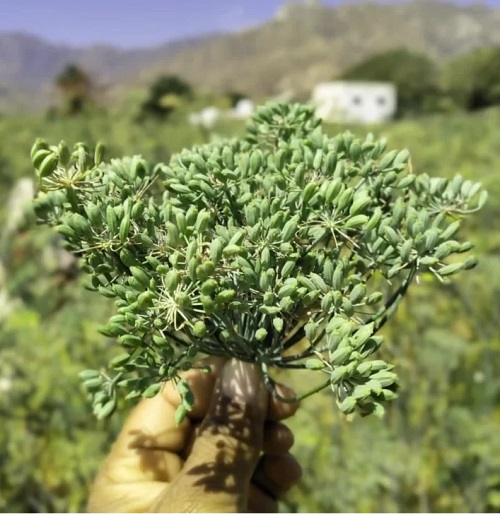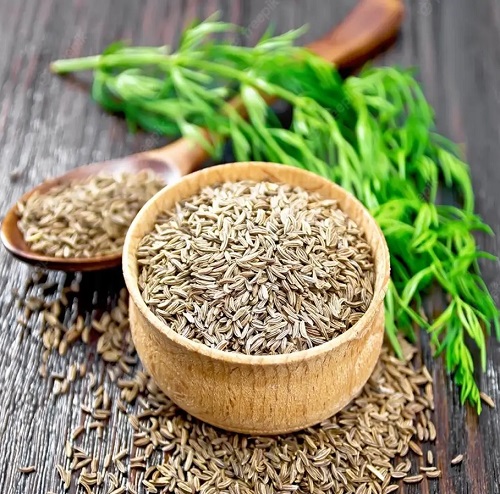The Cumin Plant has played a significant role in culinary traditions around the world for centuries. Here’s how to grow it!

Renowned for its distinctive aroma and warm, earthy flavor, Cumin Plant has become a staple spice in various cuisines, adding depth and complexity to a wide range of dishes. The best part- you can grow it at home! Here’s how!
Botanical Name: Cuminum cyminum
USDA Zones: 5-12
Read about Complete Guide for Thai Herbs and Spices here
Cumin Plant Information
The Cumin Plant is a member of the Apiaceae family and is native to the eastern Mediterranean region, including Egypt, Syria, and Turkey. It has a long history of cultivation and use dating back thousands of years.
Cumin is an annual, herbaceous plant that typically reaches a height of 20-30 inches (50-75 cm). Cumin Plant features feathery, finely divided leaves and small white or pink flowers that develop into small oblong fruits containing the seeds. The seeds, which are the part of the plant primarily used for culinary and medicinal purposes, are oblong, ridged, and have a distinct aroma.
Cumin Plant thrives in warm, arid climates and requires well-drained soil. It is typically grown from seeds, sown directly into the ground or started indoors and transplanted once the risk of frost has passed. Cumin Plant prefer full sun and require regular watering during dry periods. They are generally ready for harvest after about three to four months.
Cumin seeds are highly valued for their aromatic and warm flavor, which is earthy, slightly bitter, and peppery. They are a staple ingredient in various cuisines, including Indian, Middle Eastern, Mexican, and North African dishes.
Cumin is commonly used in spice blends, such as curry powders, garam masala, and chili powder. It adds depth and complexity to curries, soups, stews, rice dishes, roasted vegetables, and more.
Important Fact: India is the largest producer of Cuminum cyminum (cumin) – contributing 70% of the world’s total produce! The country has a long-standing history of cumin cultivation and is known for its significant contribution to global cumin production.
The climate and soil conditions in certain regions of India, particularly Gujarat and Rajasthan, are well-suited for cumin cultivation, allowing for high yields and quality production. Cumin is an essential spice in Indian cuisine and is extensively grown and exported from India to meet both domestic and international demand.
Check Herbs You Can Grow from Spice Rack here
Propagating Cumin Plant
Cumin Plant can be propagated via Seed Propagation, Stem Cuttings, Layering, Division, and by Offsets or Suckers.
Cumin Plants need a long, hot growing season and cannot tolerate frost. However, if you live in a colder climate, you can still grow cumin by starting the seeds indoors. Here’s how:
- Start Indoors: Begin by starting cumin seeds indoors, about 4 to 8 weeks before the last expected frost date. Soak the seeds for 8 hours before planting to improve germination rates.
- Use Biodegradable Pots: To avoid transplant shock, use biodegradable pots or soil blocks for seed starting. These can be directly planted in the garden without disturbing the roots.
- Planting Seeds: Plant the seeds about 1/4 inch deep in a basic potting mix. Keep the soil moist and mist regularly until sprouts appear.
- Transplanting: Once the Cumin Plant seedlings are a couple of inches tall, typically 4 to 8 weeks after sowing, and the nighttime temperatures stay above 60°F, transplant them into the garden. Choose a sunny location.
For cold climates, varieties, such as “Sjeherazade” or “Monima,” have shown better adaptability to colder climates. Since cumin has a long growing season, it’s beneficial to start the seeds indoors 6-8 weeks before the last expected frost date in your area. Plant the seeds in seed trays or pots filled with well-draining soil.
Once the threat of frost has passed and the seedlings are around 6-8 inches tall, you can transplant them outdoors. Choose a sunny location with well-draining soil.
Best Pot Size for Cumin Plant
When choosing a pot size for cumin plants, start with small pots (3-4 inches) for seedlings and then transition to larger pots (6-8 inches) as the plants grow.
For mature Cumin Plants, opt for pots with a diameter of at least 12 inches or larger. Ensure the pots have drainage holes for proper water drainage, and use durable materials like plastic, terracotta, or ceramic.
Check Spices You Can Grow in Pots here
Requirements for Growing Cumin Plant
Sunlight
Cumin Plant thrives in full sunlight. They require at least 6 to 8 hours of direct sunlight per day to grow and develop optimally. Adequate sunlight exposure ensures sturdy growth, higher essential oil content in the seeds, and better flavor.
Soil
These plants prefer well-drained soil with good fertility. Cumin Plant can tolerate a wide range of soil types, including sandy, loamy, and clay soils.
However, the soil should have good drainage to prevent waterlogging, as excessive moisture can lead to root rot. A pH range of 6.5 to 7.5 is considered suitable for cumin cultivation.
Watering
Proper watering is crucial for the healthy growth of cumin plants. During the initial growth stage, when the plants are establishing their root systems, consistent moisture is essential.
However, Cumin Plant is relatively drought-tolerant and can withstand periods of reduced watering once it has established.
Avoid overwatering, as it can lead to root diseases and affect plant health. Allow the soil to dry slightly between watering sessions, but never let it become completely dry.
Temperature
Cumin Plant is adapted to hot climates and require a temperature range of 75-104°F (24-40°C) for optimal growth. They do not tolerate frost or extremely cold temperatures.
The minimum temperature for cumin cultivation should not drop below 50°F (10°C). In cooler regions, it is advisable to grow cumin as an annual plant or provide protection during colder seasons.
Cumin Plant Care

Fertilizer
When fertilizing Cumin Plant, it is best to use a balanced liquid feed, once in 4-6 weeks, after diluting to half of its strength. If you want to avoid excessive foliage growth, then go for a 5-10-10 blend.
Organic mulch made from leaves, straw, or grass clippings is beneficial as it prevents weeds, maintains soil moisture, regulates temperature, and gradually releases nutrients as it decomposes.
Pests and Diseases
Cumin Plant can be affected by various pests and diseases. Aphids, whiteflies, and leaf miners are common pests that can cause damage by feeding on plants and hindering their growth.
You can use a strong blast of water from a hose to remove aphids from your cumin plants. Make sure to do this on a warm, sunny day so that the plants can dry out afterward, especially if they are growing closely together.
Powdery mildew, fusarium wilt, and cumin rust are fungal diseases that can affect the foliage, stems, and overall health of Cumin Plant. Root-knot nematodes are microscopic worms that infect the roots and impede nutrient absorption.
To manage these issues, regular monitoring, promoting good airflow, practicing crop rotation, and using appropriate organic pest control methods or fungicides when necessary are essential.
Check Clever Ways To Use Spices and Herbs In The Garden here
Harvesting Cumin Plant
Cumin Plant , typically takes around 120-150 days from planting to harvest. The exact time to harvest can vary depending on growing conditions, climate, and specific cultivars. Here’s a general guide on how to harvest cumin:
- Observation: Monitor the progress of your Cumin Plants as they approach maturity. Pay attention to the changes in the color and texture of the fruits, as well as the drying of the plant foliage.
- Seed Maturation: Cumin Plant produces small oblong fruits that contain the seeds. The fruits will change color from green to a light brown or yellowish-brown as they mature. Wait until the fruits are fully matured and dried on the plant.
- Timing: It is crucial to harvest cumin at the right time to ensure optimal seed development. Harvesting too early may result in immature seeds, while waiting too long could cause seeds to shatter and scatter.
- Harvesting: To harvest Cumin Plant, cut at the base using pruning shears or a sharp knife. Gather a small bunch of harvested plants and tie them together at the stem end using twine or rubber bands.
- Drying: Hang the harvested bunches in a well-ventilated, dry location, away from direct sunlight. Allow the plants to dry completely, typically taking around two to three weeks. Ensure good airflow to prevent mold or moisture-related issues during the drying process.
- Seed Extraction: Once the plants are fully dry, gently rub the dried bunches between your hands or against a screen to release the cumin seeds. The seeds will separate from the dried plant material.
- Seed Cleaning: Remove any remaining plant debris or chaff from the seeds by winnowing or using a fine-mesh sieve. This helps to obtain clean, pure cumin seeds.
Cumin Plant – Storing Seeds
After harvesting, store the cumin seeds in a cool, dry, and dark place. Proper storage conditions will help maintain their freshness. The seeds can be stored for about 2 years if kept correctly.
It’s recommended to use the seeds whole or grind them just before you’re ready to use them. This ensures maximum freshness and a stronger aroma. One delicious option is to dry roast the seeds and then grind them to create a flavorful homemade spice.
Cumin Plant – Cooking Ideas
- Spice up roasted vegetables: Toss vegetables like carrots, cauliflower, or potatoes with olive oil, cumin, and a pinch of salt. Roast them in the oven until golden and tender for a flavorful side dish.
- Create a tasty marinade: Combine cumin with other spices like paprika, garlic powder, and chili powder, along with oil and citrus juice, to create a flavorful marinade for chicken, beef, or tofu. Let the protein marinate for a few hours before grilling or baking.
- Make homemade hummus: Add a pinch of cumin to your homemade hummus for an extra layer of flavor. It pairs well with the creamy chickpeas and tahini.
- Flavor your soups and stews: Enhance the taste of your soups and stews by adding cumin. It works particularly well in tomato-based soups, lentil soups, and chili.
- Season your rice or grains: Add cumin to your rice or grains while cooking to infuse them with a delightful aroma. It works great in dishes like pilaf, biryani, or Mexican-inspired rice.
- Elevate your dips and sauces: Sprinkle cumin into yogurt-based dips like tzatziki or sour cream-based sauces for a burst of flavor. It complements well with garlic, lemon, and herbs.
- Spice up your homemade burgers: Mix cumin into your burger patties along with other spices to add depth and richness to the flavor. It works well with beef, turkey, or even vegetarian burger recipes.
- Experiment with cumin-spiced roasted nuts: Toss mixed nuts with a blend of cumin, cayenne pepper, salt, and a touch of honey or maple syrup. Roast them in the oven for a delicious and spicy snack.






